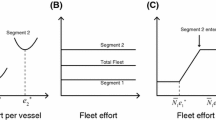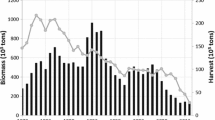Abstract
An empirically estimated harvest function for an off-shore longline fishing vessel is integrated with a demand model for swordfish, and costs. This integrated model is used to examine the economic viability of the conventional pre-trip revenue share scheme between fishing vessel crews and owners, and then to explore optimal fishing efforts to maximise profits. The results demonstrate explicit outcomes of fishing efforts in economic benefits between rational fishing behaviour based on the conventional revenue sharing scheme and optimum fishing efforts to maximise seasonal economic profit. This is due to the trade-off between the quality of landed fish and pursuing more fishing opportunities during a trip. There is a discrepancy between a crew’s rational choice of fishing efforts to maximise their share per trip and the vessel owners’ preference to maximise seasonal profit. We propose that it is necessary to move from the conventional remuneration scheme to align economic incentives and maximise economic benefits for both vessel crews and owners.





Similar content being viewed by others
References
Asche F, Hannesson R (2002) Allocation of fish between markets and product forms. Mar Resour Econ 17:225–238
Barten AP, Bettendorf LJ (1989) Price formation of fish. An application of an inverse demand system. Eur Econ Rev 33:1509–1525
Branch TA, Hilborn R, Haynie AC, Fay G, Flynn L, Griffiths J, Marshall KN (2006) Fleet dynamics and fishermen behavior: lessons for fisheries managers. Can J Fish Aquat Sci 63:1647–1668
Brodziak J, Ishimura G (2011) Development of Bayesian production models for assessing the North Pacific swordfish population. Fish Sci 77:23–34
Cai J, Leung P, Pan M, Pooley S (2005) Economic linkage impacts of Hawaii’s longline fishing regulations. Fish Res 74:232–242
Comitini S, Huang DS (1967) A study of production and factor shares in the halibut fishing industry. J Polit Econ 75:366–372
Curtis RE, McConnell KE (2004) Incorporating information and expectations in fishermen’s spatial decisions. Mar Resour Econ 19:131–143
Duy NN, Flaaten O (2016) Efficiency analysis of fisheries using stock proxies. Fish Res 181:102–113
Eales J, Wilen J (1986) An examination of fishing location choice in the pink shrimp fishery. Mar Resour Econ 2:331–351
Eggert H (2001) Technical efficiency in the Swedish trawl fishery for Norway lobster. In: The international institute of fisheries economics and trade (IIFET) 2000 proceedings, pp 1–19. Ed. by IIFET. IIFET, Corvallis, Oregon, USA
Eide A, Skjold F, Olsen F, Flaaten O (2003) Harvest functions: the Norwegian bottom trawl cod fisheries. Mar Resour Econ 18:81–93
Ekerhovd N-A, Gordon DV (2013) Catch, stock elasticity, and an implicit index of fishing effort. Mar Resour Econ 28:379–395
Felthoven RG, Morrison Paul CJ (2004) Multi-output, nonfrontier primal measures of capacity and capacity utilization. Am J Agric Econ 86:619–633
Fulton EA, Smith ADM, Smith DC, Van Putten IE (2011) Human behaviour: the key source of uncertainty in fisheries management. Fish Fish 12:2–17
Garcia-Enriqueza J, Murillas-Mazab A, Artechea J (2016) Economic structure of fishing activity: an analysis of mackerel fishery management in the Basque Country. Economia Agraria y Recursos Naturales 16:81–109
Gillis DM (2003) Ideal free distribution in fleet dynamics. Can J Zool 81(2):177–187
Grant S, Berkes F (2007) Fisher knowledge as expert system: a case from the longline fishery of Grenada, the Eastern Caribbean. Fish Res 84:162–170
Greenville J, Hartmann J, Macaulay TG (2006) Technical efficiency in input-controlled fisheries: the NSW ocean prawn trawl fishery. Mar Resour Econ 21:159–179
Guillen J, Macher C, Merzéréaud M, Boncoeur J, Guyader O (2015) Effects of the share remuneration system on fisheries management targets and rent distribution. Mar Resour Econ 30:123–138
Hannesson R (1983) Bioeconomic production function in fisheries: theoretical and empirical analysis. Can J Fish Aquat Sci 40:968–982
Hicks RL, Schnier KE (2008) Eco-labeling and dolphin avoidance: a dynamic model of tuna fishing in the Eastern Tropical Pacific. J Environ Econ Manag 56:103–116
Hilborn R, Costello C (2018) The potential for blue growth in marine fish yield, profit and abundance of fish in the ocean. Mar Policy 87:350–355
Huang KS (1994) A further look at flexibilities and elasticities. Am J Agr Econ 76:313–317
Ishimura G, Bailey M (2013) The market value of freshness: observations from the swordfish and blue shark longline fishery. Fish Sci 79(547–553):5
Kirkley J, Squires D, Strand I (1995) Assessing technical efficiency in commercial fisheries: the Mid-Atlantic Sea Scallop Fishery. Am J Agr Econ 77:686–697
Matthiasson T (1999) Cost sharing and catch sharing. J Dev Econ 58:25–44
Maunder MN, Sibert JR, Fonteneau A, Hampton J, Kleiber P, Harley SJ (2006) Interpreting catch per unit effort data to assess the status of individual stocks and communities. ICES J Mar Sci 63:1373–1385
McCluskey SM, Lewison RL (2008) Quantifying fishing effort: a synthesis of current methods and their applications. Fish Fish 9:188–200
Mistiaen JA, Strand IE (2000) Location choice of commercial fishermen with heterogeneous risk preferences. Am J Agr Econ 82:1184–1190
Nguyen Q, Leung P (2009) Choice of remuneration regime in fisheries: the case of Hawaii’s longline fisheries. J Agric Resour Econ 34:498–517
Nøstbakken L (2006) Cost structure and capacity in the Norwegian pelagic fisheries. Appl Econ 38:1877–1887
Pascoe S, Coglan L (2002) The contribution of unmeasurable input to fisheries production: an analysis of technical efficiency of fishing vessels in the English channel. Am J Agric Econ 83:585–597
Pascoe S, Herrero I (2004) Estimation of a composite fish stock index using data envelopment analysis. Fish Res 69:91–105
Pradhan NC, Leung P (2004) Modeling trip choice behavior of the longline fishers in Hawaii. Fish Res 68:209–224
Pradhan NC, Sharma KR, Leung P (2003) Analyzing technical and economic interrelationships in Hawaii’s longline fishery. Mar Resour Econ 18:167–193
Reimer MN, Abbott JK, Wilen JE (2017) Fisheries production: management institutions, spatial choice, and the quest for policy invariance. Mar Resour Econ 32:143–168
Sanders MJ, Morgan AJ (1976) Fishing power, fishing effort, density, fishing intensity and fishing mortality. ICES J Mar Sci 37:36–40
Scheld AM, Anderson CM, Uchida H (2012) The economic effects of catch share management: the Rhode Island Fluke Sector Pilot Program. Mar Resour Econ 27:203–228
Sharma KR, Leung P (1999) Technical efficiency of the longline fishery in Hawaii: an application of a stochastic production frontier. Mar Resour Econ 13:259–274
Smith MD (2000) Spatial search and fishing location choice: methodological challenges of empirical modeling. Am J Agric Econ 82:1198–1206
Acknowledgements
The authors are grateful to the three anonymous reviewers who provided substantive suggestions to improve an earlier version of this paper. The authors also thank KDWFC and the members of the KDWFC for providing data and continuous support for their research activities. This work was supported by the JSPS Grants-in-Aid for Scientific Research 17K07903.
Author information
Authors and Affiliations
Corresponding author
Additional information
Publisher’s Note
Springer Nature remains neutral with regard to jurisdictional claims in published maps and institutional affiliations.
Rights and permissions
About this article
Cite this article
Ishimura, G., Abe, K., Kanazawa, K. et al. Exploring economic optimum fishing efforts: a case of Japanese swordfish longline fishery. Fish Sci 88, 245–258 (2022). https://doi.org/10.1007/s12562-022-01587-0
Received:
Accepted:
Published:
Issue Date:
DOI: https://doi.org/10.1007/s12562-022-01587-0




